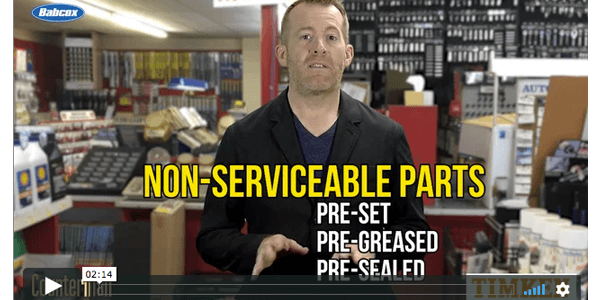Today we’re talking bearings and hub units. In my last video, we reviewed how hub units have made life easier for not only you as a parts professional, but your technician customer and ultimately, the motorists out on the road.
In review, hub assemblies are: No. 1. unitized. That means all in one unit. Makes sense to me. No. 2.: They’re maintenance-free. No. 3. They contain non-serviceable parts that are preset, pre-greased and pre-sealed. No. 4. They ease installation and increase product reliability for enhanced performance. But let’s talk about when bearings go bad.
One of the leading causes of failure is the seal. After all, the inside of a bearing can be a hot place. When a bearing is cooling off, the contracting metal, air and lubricant can create a vacuum that is usually held by the seals. If the seals are worn and can’t hold the vacuum, the bearing or sealed hub unit will suck in outside air, debris and water. In some parts of the country that use salt on the roads, it can almost be as corrosive as ocean water on the wheel bearings.
As these contaminants circulate through the grease and between the races and bearings, the components wear. Once a bearing is worn, the wear rate is accelerated by seals that no longer keep out contaminants, and increased heat may break down and eventually expel the lubricants. This is a slippery slope that could quickly lead to catastrophic failure.
Does your customer need to uncover why the previous bearing failed. Yes. For the repair to be successful, your technician customer must first determine why the previous bearing failed. But for sealed hub units, examining the internal bearings and races is impossible. So how does your customer figure it all out? They have to be a detective of sorts and ask their customer some questions. They’ll need to find out what kind of roads the motorist drives on.
What types of loads they carry. If a motorist overloads the vehicle, bearing damage could be inevitable. The most common failure pattern for bearings is for those on the passenger side of the vehicle to fail first since the passenger-side bearings are exposed to the most standing water in the gutter. If the bearings on the driver’s side of the vehicle fail first, the passenger side bearings will likely fail pretty soon, too. Getting back to hubs specifically, a cheaper hub unit has the same appearance as a high-quality, brand-name unit. What is the difference?
Bearings are precision products that require complex manufacturing processes. Inferior bearings that use low-quality steel and have poor heat-treating can wear and spall prematurely. The poor-quality steel may have inclusions of hard or soft metal that can cause a premature failure. In summary, an inexpensive bearing may look the same as a high-quality bearing, but sometimes it is what you can’t see that makes a difference between a comeback and a satisfied customer. Also, some cheaper hub units use smaller bearing sizes than the OEM intends. This can lead to premature failure.






